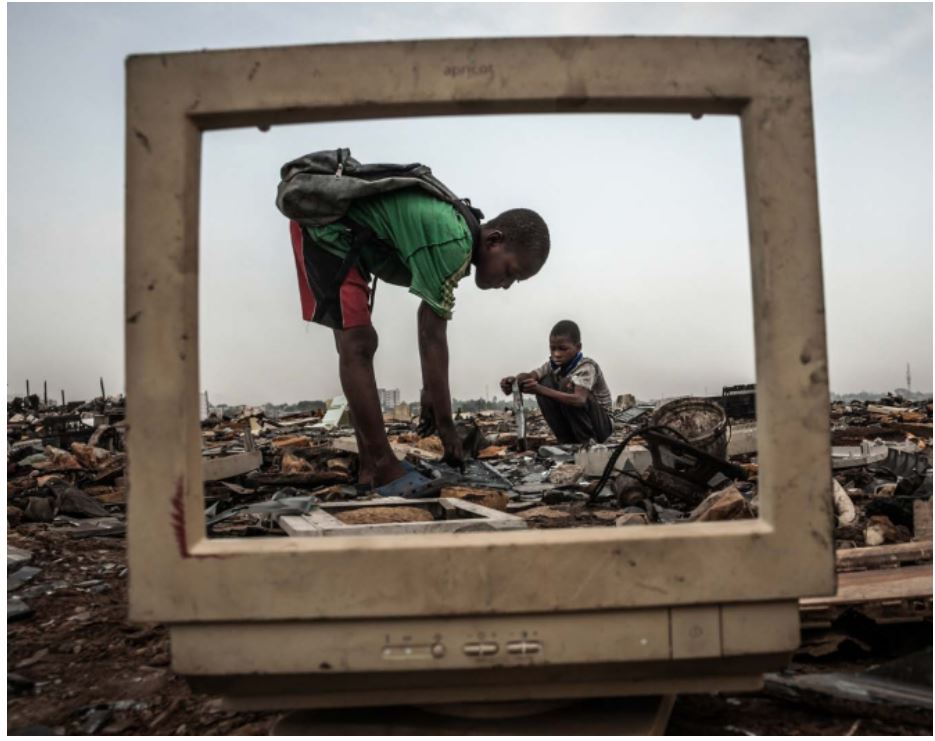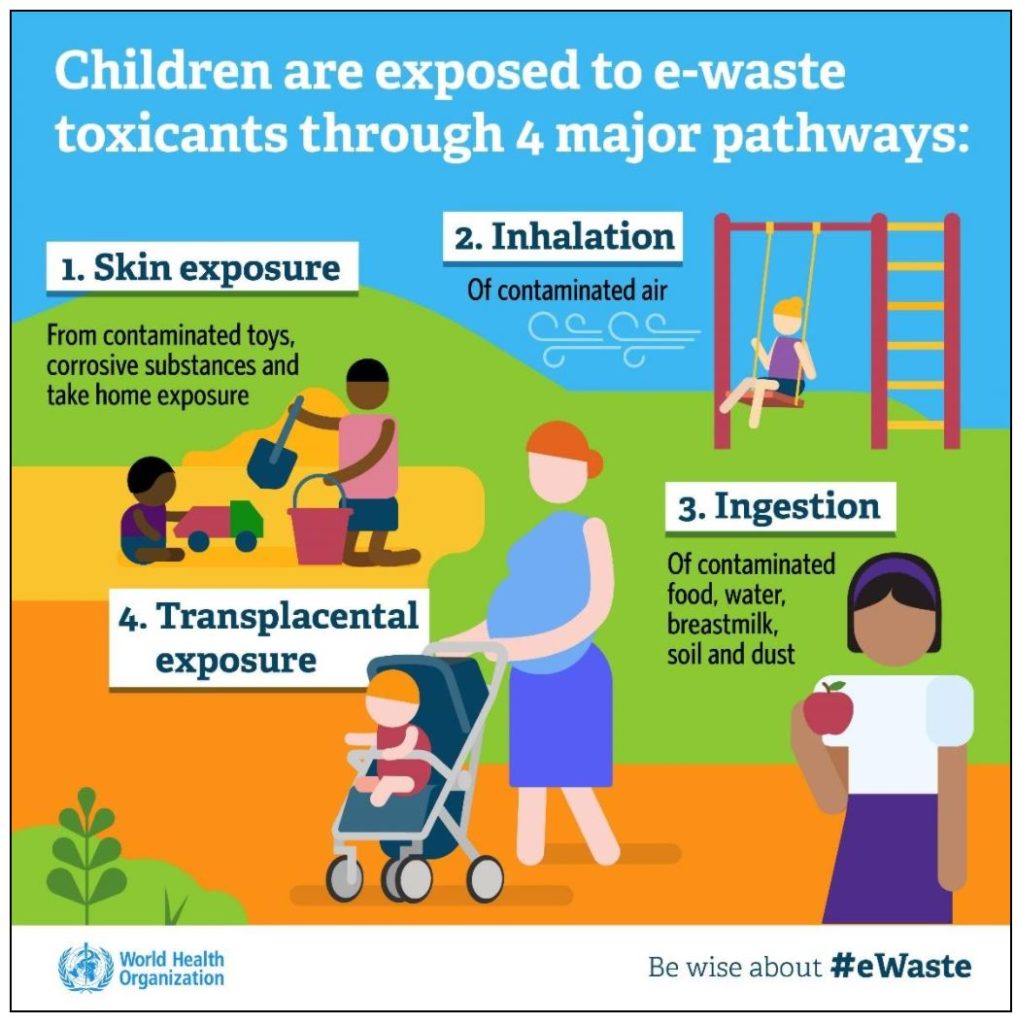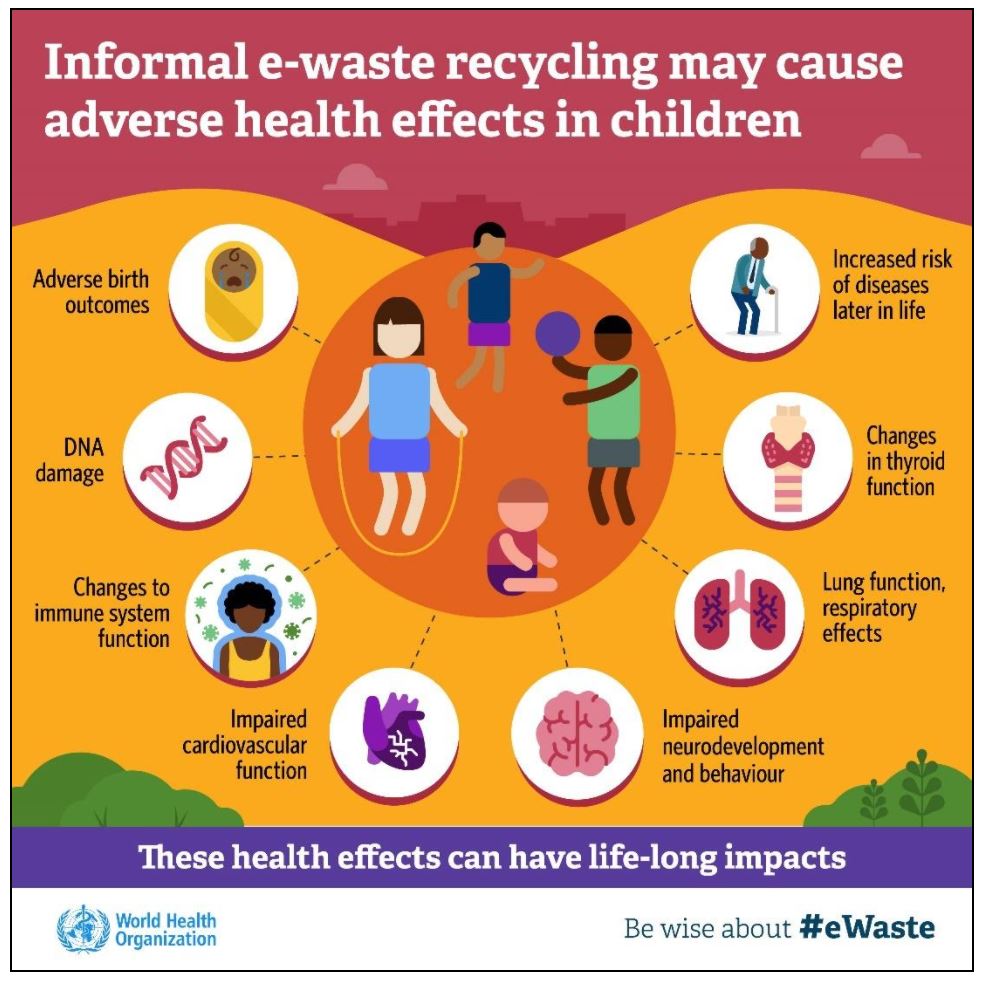The WHO recently released a report that outlines the link between informal e-waste recycling activities and health outcomes in children. As per this report, 18 million children & 12.9 million women, may be at risk from adverse health outcomes linked to e-waste recycling. Here is a review with a focus on India.
e-waste or electronic waste refers to all the electrical and electronic equipment and their components which have been discarded as waste. With the advancement in technology and the increasing usage of electronic products for multiple needs, it is no surprise that the generation of e-waste is increasing at a rapid pace. Peoples’ insatiable demand, technology uptake and shorter replacement cycles are some of the reasons behind the exponential growth in e-waste. In Europe, USA, and China, the average mobile phone is disposed of in less than two years. Even the United Nations has repeatedly warned that a ‘Tsunami of e-waste’ would hit the world soon.
According to World Economic Forum’s report in 2019, the e-waste produced annually was worth over $ 62.5 billion, more than the GDP of most countries. In addition to being a huge environmental problem, millions of children are affected by the mounting e-waste. This story reviews the recent report on e-waste and child health- ‘Children and digital dumpsites: e-waste exposure and child health’, published by WHO.

Volume of e-waste generated is increasing considerably
In the year 2019 alone, the WHO has estimated that about 53.6 million tonnes (MT) of e-waste was generated globally. Compared to 2014, the year from when the global statistics of e-waste are formally available, the global e-waste generated has increased by 9.3 MT (nearly 21%). In 2014, the total e-waste was 44.4 MT. By 2030, global e-waste is estimated to increase to 74.7 MT. The per capita e-waste has also increased from 6.4 kg in 2014 to 7.3 kg in 2019 and is expected to reach around 9 kg by 2030. One of our earlier stories looks at the trend in the total quantity of e-waste generated, category-wise and regional contributions in detail based on the Global E-waste Monitor- 2020. With the pandemic forcing people to stay and work indoors, the usage of electric & electronic equipment is only going to increase further.
12 countries accounted for nearly 2/3rds of the e-waste generated in 2019
Among all the countries, China produced the most e-waste, accounting for almost 19% (10.12 MT) of the e-waste generated globally. The USA produced the second-highest, followed by India. Overall, 12 countries together produced more than 3.5 million tonnes of e-waste and accounted for more than 65% of the e-waste generated worldwide in 2019. About 166 countries contributed the remaining 35%.
Only 17.4% of the e-waste reached formal waste disposal settings
Of the 53.6 million tonnes of e-waste generated in 2019, only 17.4% (9.3 MT) reached formal management or recycling facilities, according to the most recent estimates of United Nations University. The remaining 82.6% (44.3 MT) was illegally dumped, overwhelmingly in low- or middle-income countries such as areas of Asia, Africa, and Latin America.
Advanced economies ship e-waste as ‘second-hand equipment’ to low/middle-income countries
Besides their increasing volume of e-waste, the digital debris of advanced economies is shipped to the countries in East and Southeast Asia to bypass domestic recycling rules. The Basel Convention on the Control of Transboundary Movements of Hazardous Wastes and Their Disposal, and the Stockholm Convention on Persistent Organic Pollutants are two important global conventions that address the transport and disposal of hazardous chemicals and waste. According to Basel Convention, such illegal movement of hazardous waste is to be prevented and the transboundary movement of hazardous wastes and other wastes is reduced to the minimum consistent with environmentally sound and efficient management. However, to circumvent this, the waste is shipped to receiving nations as ‘second-hand equipment’. The recipient countries may re-sell some of the most serviceable devices. However, the rest is dumped in informal or formal waste sites.
Health of workers is affected due to exposure to toxic chemicals like lead and mercury
The discarded electronic devices may contain valuable components such as gold, copper, etc. In the informal setting, such equipment is dismantled and recycled through primitive techniques, which may include burning, heating, or soaking in chemical baths. Necessary precautions are not usually taken by the workers, especially in the informal sector, which exposes them to toxic chemicals like mercury, lead, chromium, dioxins, and flame retardants, and air polluted with toxic particles, fumes, and other residues which significantly affects their health. Environmental damage such as air pollution or leaching of hazardous chemicals into soil and water, contaminating entire communities.
Children are at higher risk to exposure
Data on the number of persons engaged in e-waste recycling or the number of dumpsites is not clearly available. Different studies have come up with estimates on the number of persons engaged in the informal waste sector. An assessment ascertained that there were 12.5–56 million people working worldwide in the informal waste sector. Another review by the World Bank estimated 15 million informal waste workers and International Labour Organization’s estimate was 19– 24 million waste workers worldwide with 15–20 million in the informal sector. Considering the proportion of women working in the industrial sector, 2.9–12.9 million women are estimated to be working in the informal waste sector. A significant proportion of them are in childbearing years and are likely to be pregnant during their work, thereby, exposing the unborn child to toxicants directly and by passing on during pregnancy.
Around 152 million children, aged 5 to 17 years, are working as child labour with some 73 million children worldwide working in hazardous labour and more uncounted numbers in the informal waste recycling sector. It is estimated that around 18 million children are employed illegally in various forms of the industry including e-waste and its management. Children are engaged in e-waste recycling because their small hands are more dexterous than those of adults. Children who go to schools near e-waste recycling centres are also vulnerable as the child’s body is in a developing stage. The hazardous impact of working at such sites is also experienced by families and communities that reside in the vicinity of these e-waste dumpsites. For instance, a child who eats just one chicken egg from ‘Agbogbloshie’, a waste site in Ghana, absorbs 220 times the European Food Safety Authority’s daily limit for intake of chlorinated dioxins.
Children absorb more pollutants relative to their size and hence are not able to metabolize or eradicate toxic substances from their bodies. Children are exposed to e-waste toxicants through skin exposure, inhalation, ingestion, and transplacental exposure. Children’s right to life, survival, and development is compromised in the process.

Severe health complications are caused by exposure to toxicants from e-waste
Impaired neurodevelopment and behaviour, negative birth outcomes like stillbirth and premature births, lung function and respiratory effects, impaired thyroid and cardiovascular system function, DNA damage, impacts on immune system functions, increased risk of some chronic diseases including cancer and cardiovascular diseases later in life, are some of the adverse health impacts of prenatal exposure and childhood e-waste exposure.

Governments must devise and strictly implement necessary policies
As per the report, only about 71% of the global population lives in a country with some form of e-waste management legislation. However, this does not mean that the policy is implemented properly. Only about 77 countries out of 180 have some form of legislation that addresses e-waste management. Despite being party to various international agreements, countries continue to exploit loopholes.
Stringent measures ensuring the protection of health and environment- both for manufacturing and waste management of electronic equipment should be adopted. Formalization of the waste management sector and continuous surveillance will be helpful. Labour laws should be modified to ensure the health of workers is not jeopardized. In addition, the healthcare system should be strengthened, and people should be sensitized about the hazards of e-waste.
Further, the availability of data on the generation of waste, dumping, workers, etc. will help monitor the sector better. All this is possible only when there is proper enforcement of the existing laws.
India is third largest producer of e-waste
India generated 3.2 million tonnes of e-waste in 2019, the third-highest after China and the US. According to the Central Pollution Control Board, India generated more than a million tonnes of e-waste in 2019-20 across the 21 types of electrical and electronic equipment listed in the E-Waste Management Rules, 2016. However, India collected just 3.5% of the e-waste estimated to have been generated in the country in 2017-18 and 10% in 2019-20. The 2016 rules enforce the Extended Producer Responsibility (EPR) which holds the producer responsible for the collection of a certain percentage of e-waste. State Pollution Control Boards (SPCB) are supposed to into authorization for the recovery of materials. SPCBs are also responsible for checking informal trading, dismantling, and recycling of waste.
Despite legislation, Child Labour in e-waste management sector continues in India
95% of e-waste in India is recycled by the informal sector and only 5% is recycled by the formal sector, according to the Ministry of Environment & Forests (MoEF) in 2018. Scrap dealers collect the e-waste and dispose of the same in an unscientific manner such as burning, dissolving in acids, and leaching. Around 4.5 lakh children aged 10 to 14 years were engaged in various e-waste activities, without adequate protection and safeguards in 2014. The practice continues to be reported from different parts of India such as Delhi and Uttar Pradesh, as per the 2020-21 report of the National Commission For Protection Of Child Rights. This is despite India’s Child Labour (Prohibition and Regulation) Act 1986 and its amendment in 2016 which prohibits the engagement of children in hazardous occupations. The Mines Act, 1952, Indian Factories Act, 1948, and The Merchant Shipping Act, 1958 also prohibit children from engaging in paid labour.
e-waste disposal is a matter of global concern not only because of its direct environmental and social consequences but also because the health of millions of children is put at risk. Thus, countries across must establish the required infrastructure and formalize the sector.
Featured Image: Effects of e-waste exposure on Child Health


